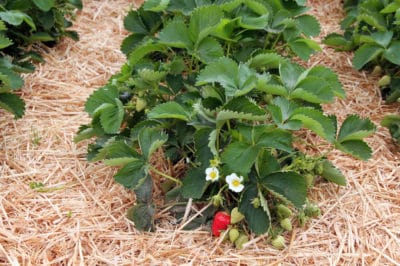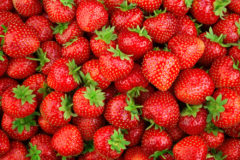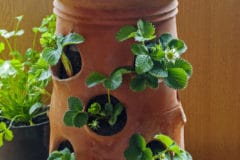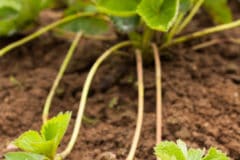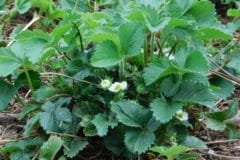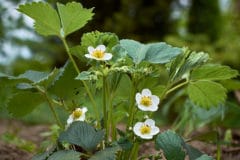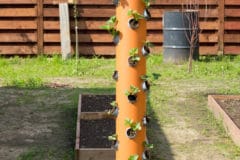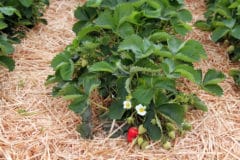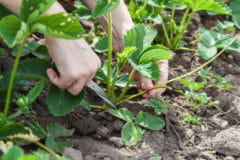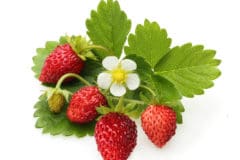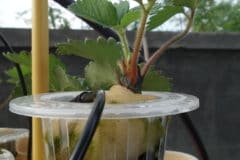Strawberries of the Past
Hundreds of years ago wild strawberries flourished from Canada south to the Carolinas and west to the Appalachian Mountains. Native American Indian tribes cultivated wild strawberries, transforming them into a sweeter and redder berry.
One can only imagine how large strawberry patches became in the wild hundreds of years ago. Daniel Boone was known to walk miles out of the way to spend time in a strawberry patch full of ripe berries.
Planning the Strawberry Patch
Planning your strawberry patch a year prior to planting may produce a better crop. From deciding on the location of the patch through the storing of the harvest, there are many decisions to make.
Location of the Strawberry Patch
The location to start your strawberry patch is the first consideration. Choosing an area that gets enough sunlight is crucial. The ideal amount of sunlight per day is 10 hours or more. Never attempt growing in an area that gets less than 6 hours of sunlight.
Soil of the Strawberry Patch
Once the right location is determined, the soil should be prepared. Adding rotted manure or compost months to a year prior will greatly improve the soil. A soil test is beneficial in determining what if anything is needed to achieve optimal pH (between 5.5 and 6.8) and fertility.
Adequate soil drainage is crucial to the health of strawberry plants. Poorly drained soil encourages disease and fruit rot. Heavy clay soil can be improved by adding organic matter such as composted leaves, vermiculite, or fully rotted sawdust. Mix a few inches or more into the soil. If necessary, drainage tiles or sand can be used for improved drainage.
Strawberry patch soil has to drain well, but it also needs good water retention. Adding sphagnum peat moss or coir (coconut fiber) can improve water retention. These products also have a dual benefit of improving drainage.
The strawberry patch location should be in an established garden soil, but not in soils that grew certain crops in the last four years. The same diseases that harm these crops can also harm strawberry plants. Diseases such as verticillium and fusarium wilt can remain in the soil that grew these crops:
- Potatoes
- Peppers
- Tomatoes
- Raspberries
- Blackberries
Strawberry Patch Layout
Strawberry patches do not have to be planted in traditional rows or in the corner of a backyard. Long, narrow patches of green and red can add beauty to the edge of any landscape garden. A backyard pathway to a shed could be bordered with strawberry plants also. Design possibilities are endless.
Strawberry growers that prefer a more traditional layout can still achieve a visually appealing strawberry patch. Using a pyramid planting system is one way to draw eyes to the plants. The bottom frame, usually a square or circle, is filled with soil followed by a second smaller frame in the center. More frames can be added.
Determining how and where to plant strawberry plants should precede buying the plants. Knowing how much growing space is available is necessary for determining the number of plants to purchase.
Strawberry Types
The amount of growing space should be considered when determining what type of strawberries to grow. There are three types of strawberries: everbearing, day-neutral, and June Bearing. Everbearing strawberries are best in limited space gardens. These produce little to no runners. Day-neutral strawberries, producer of some runners, are also okay for limited space gardens.
June bearing strawberries produce only one crop per season. There are early, mid-season and late season varieties. To lengthen the harvest, a strawberry patch can include varieties that ripen in the different parts of the growing season. June bearing strawberries usually bear larger berries and larger amounts of berries than the other types of strawberries.
Everbearing strawberries produce a crop in June or July and again in the fall. Day-neutral strawberries produce continually through the growing season except when it is extremely hot. These growth characteristics should be considered before choosing what strawberry type is best for your patch.
Strawberry Varieties
Second to eating the sweet berries, picking the variety or cultivar may be the most enjoyable part of strawberry growing. With dozens of choices, choosing may be overwhelming. Narrow your choices down by checking with your local county extension. The best cultivars for your USDA Zone will be recommended. Some varieties to consider are:
- Fort Laramie (everbearing)
- Tribute (day-neutral)
- Allstar (June bearing)
- Annapolis (June bearing)
- Quinault (everbearing)
- Selvia (day-neutral)
- Brunswick (June bearing)
- Cabot (June bearing)
- EverSweet (everbearing)
- Seascape (day-neutral)
- Darselect (June bearing)
- Earliglow (June bearing)
- Ozark Beauty (everbearing)
- Tristar (day-neutral)
Amount of Plants Needed
Part of your strawberry patch planning should be measuring your available growing area then deciding how many plants will fit in the area. Using a garden planning app, gardening software, or old-fashioned graph paper can aid in determining how many plants to purchase. Remember to include space for pathways in your plans.
The recommended spacing of mother strawberry plants varies depending on the source. No source recommends planting the mother plant less than 12 inches apart: none recommend more than a 30-inch spacing for June bearing varieties. The best spacing recommendations will come from the nursery where the plants originated. If your plants were gifts, research spacing information on the variety.
Strawberry Patch Planting Time
A well-prepared strawberry grower purchases the plants at just the right time. Nurseries will guide you to the proper time for your USDA Zone. The plants should be planted or potted within 24 hours of receipt or wrapped and refrigerated for no more than a few days.
Strawberry growers in USDA Zone 7 and southward plant in the fall. Growers in USDA Zone 6 and northward plant as soon as the soil can be worked in the spring or four to six weeks before the last frost. The soil can be worked much sooner if good drainage is established in the months or year prior to the growing season.
Planting the Strawberry Patch
After the soil is prepared, the actual planting is simple. Use a trowel or small spade to open a V-shaped hole in the soil. The hole needs to be 6 inches (15 cm) deep and wide enough to accommodate the roots. The roots can be shortened to no less than 4 inches (10 cm).
The proper planting depth is crucial to the life of the strawberry plant. The center of the crown of the plant or runner should be at the soil line. All roots need to be completely buried and not bending upwards. At planting time, use an organic fertilizer. Fertilize again about a week or two before harvest.
Growing Season Chores
Late frosts can occur after strawberry plants are placed in the strawberry patch. It is wise to be prepared to cover the plants with old sheets or blankets. If the temperature is expected to drop to 25°F (-4°C) or lower, row covers or spun bond material can be used to protect the plants.
Strawberry plants grow best in temperatures ranging from 60°F (16°C) to 80°F (27°C). The flowers begin appearing as soon as the temperature starts to warm up in the spring. The fruit that develops from the flower blossoms will ripen in four to six weeks.
Blossom removal is necessary the first year of growth. June bearing strawberry blossoms must be removed as soon as they appear. This promotes runner and root development. It also ensures a better crop the following season. Stop removing the blossoms of everbearing and day-neutral varieties at the end of June. Some fruit will be harvested in summer or fall.
During the growing season, runners will begin to appear. Press the ends of the runners gently into the soil to encourage rooting of daughter plants. Use pruning shears or sharp scissors to cut runners that grow excessively.
Post-Growing Season Chores
In the fall or winter before temperatures drop below 20°F (-7°C), apply 3 to 4 inches of straw over the strawberry plants. Mulching will help protect against bud, root, and crown damage. Move the mulch to the aisles the following spring when the plant leaves show yellow. To conserve soil moisture, a thin layer of mulch can remain around plants.
